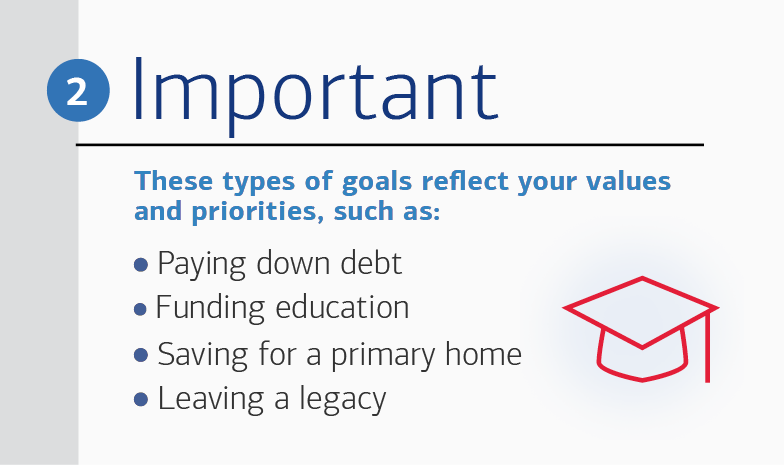5 ways to juggle competing financial goals
College tuition, retirement savings and more — your financial goals can sometimes seem overwhelming. This five-step process can help you pursue them all.
WHETHER YOU’RE JUST STARTING OUT OR WELL INTO YOUR PEAK EARNING YEARS, it may not always seem like there’s enough money coming in to cover your current expenses and save for future needs.
Consider all the potential claims on your finances: a down payment on a home, your children’s college tuition, a parent who requires caregiving and, of course, retirement accounts that need regular care and feeding. That’s in addition to ongoing expenses and periodic big outlays like a new car.
“Categorizing your goals as essential, important or aspirational — and identifying them as short- or long-term — can help you create a plan for intentionally and thoughtfully allocating your resources.”
How do you juggle these competing demands? “It’s essential to take a step back and consider your goals and your values,” says Valerie Galinskaya, managing director and head of the Merrill Center for Family Wealth™. She suggests the following five-step approach. “Using this process, you can identify and prioritize your goals and then create a realistic plan for pursuing them.”
1. Take note of your values and goals
Start by sitting down with your family to create a list of words and phrases describing your values, or what’s most important to you. “Then you can craft a few short value statements — one or two sentences at most — that you can use to guide your family’s financial decisions,” says Galinskaya. For example, if you’ve identified giving back to your community as an important value, that commitment could help to inform other spending, saving and investing decisions. Next, make a list of your goals. Your values will help to shape and, in some cases, temper them.
2. Sort your list
Prioritizing your financial goals can help you pursue them more effectively. To do this, decide which of these buckets each goal belongs in:
- Essential goals, such as saving for retirement, building an emergency fund and preparing to cover rising healthcare costs as you age, absolutely can’t be put off.
- Important goals are less critical but represent core values. They may include funding education, saving for a home, paying down debt or leaving a legacy.
- Aspirational goals are anything that’s merely nice to have — say, a second home or a big trip — and they should be lowest among your priorities.
“Categorizing your goals as essential, important or aspirational — and identifying them as short- or long-term — can help you create a plan for intentionally and thoughtfully allocating your resources,” says Galinskaya.
3. Get family members on the same page
Even couples and families with similar goals can differ when it comes to priorities, notes Galinskaya. To narrow down a list of goals or priorities, Galinskaya suggests a technique she calls “The Fist of Five.” A goal is proposed and discussed, then each family member votes by raising zero to five fingers, representing their level of support. “The process continues until every goal on the list gets at least three fingers from everyone,” says Galinskaya. “That way, you’re not just getting compromise; you’re building consensus.”
4. Build your investments around your priorities
Now you’re ready to put investment strategies in place to help you pursue your goals. “Start with the essential goals,” says Galinskaya. Once you have a solid strategy for funding those, you can create strategies to invest for your important goals and, finally, plan ways to invest for your aspirational goals. Consider your risk tolerance and the amount of time you have to pursue each of these goals as you build your portfolio. You may also consider other investments, such as a health savings account to help cover long-term medical costs, or a 529 education savings account to prepare for tuition expenses.
For a goal requiring near-term funding — say, you hope to purchase a vacation home within one to three years — you’ll probably want to keep the money in a safe, liquid account such as a CD or money market account. For goals more than five years away — perhaps your son, daughter or a grandchild will be ready to start college in that time frame — you may consider adding higher-risk/higher-reward assets to your portfolio. For goals 10 years out or longer, such as retirement, you might invest more aggressively for growth, because your investments should have time and potential to rebound from any market dips.
5. Reconsider your plan periodically
Life changes such as divorce or a new job, or unforeseen economic events, may necessitate a second look at your plans. “You may need to add or subtract goals or change their timelines,” says Galinskaya. Say you really want to change careers, even if it means postponing retirement. Think about the potential impact of this decision across all of your goals. That way you can make considered decisions that don’t shortchange any of the things that matter most to you.
“Along the way, you may very likely have to make trade-offs,” says Galinskaya. “But by using this five-step process, you’ll be armed with the knowledge you need to help you prioritize your goals and align your assets toward pursuing them.”
Choose your advisor in a more personalized way
All our advisors are committed to putting your needs and priorities first. Find some who match your personal preferences too.







